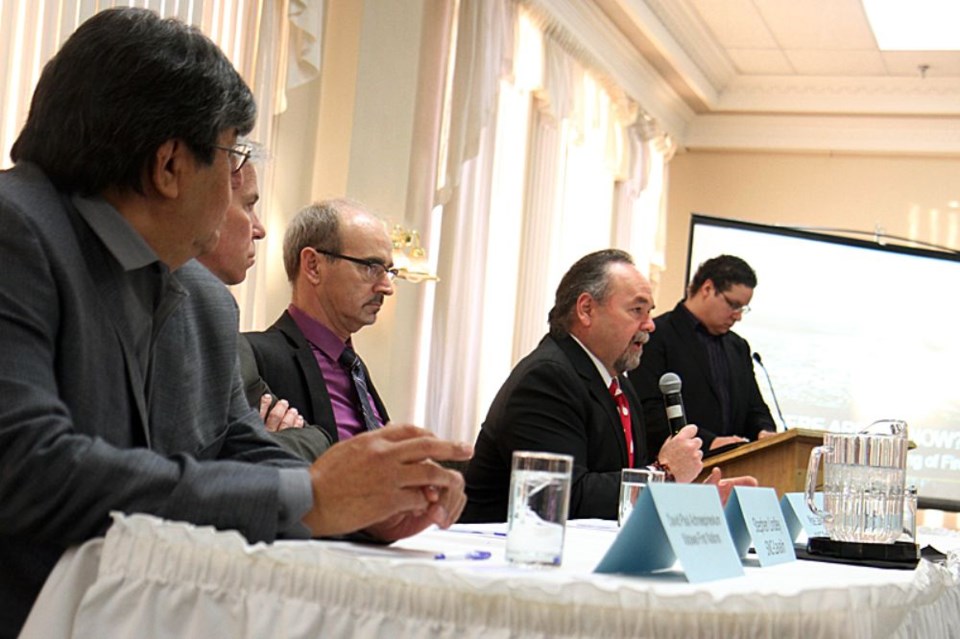THUNDER BAY – A federal treasury board statement indicating that now may not be the time to move forward with Ring of Fire development has drawn sharp criticism from at least one major stakeholder.
Tony Clement was a guest speaker at a Timmins Chamber of Commerce luncheon Monday where he told the audience he does not anticipate the federal or provincial governments taking a larger role in the Ring of Fire until mineral prices rise.
Mo Lavigne, KWG Resources vice-president of exploration and development, was a panelist at a Ring of Fire discussion hosted by the Thunder Bay Chamber of Commerce Tuesday. He responded to Clement’s statement, telling reporters after the event that the idea of current commodity prices negatively affecting development is misguided.
“He’s really regurgitating a narrative that’s totally incorrect,” lavigne said. “For chromium and nickel this is exactly the right time to be developing the Ring of Fire.
“I think it’s more misinformed commentary than anything else … People making uninformed comments is rampant these days. It’s so commonplace and unfortunately it’s not really helping us make good decisions.”
He added that the only markets suffering seriously is iron ore, which played a role in Cliffs Natural Resources backing out.
But the markets remain stable for the chromite.
“It’s a very flat market. For the last 50 years the consumption of stainless steel has grown steadily at six to seven per cent per year and it’s going to continue to grow steadily,” he said.
“It’s stainless steel consumption that drives ferrochrome production that drives chromite mining. We expect the business case for chromium mining to be very good.”
Another company heavily invested in the Ring of Fire is waiting for the province to allow them to continue taking steps forward.
Glenn Nolan, Noront Resources vice-president of Aboriginal Affairs, said the company is in a holding pattern with their Eagle’s Nest nickel project and needs the Ontario government to move their permits approved.
Noront has been waiting for 125 weeks to receive a response to their environmental assessment terms of reference.
“We want to hire more people. We have a whole cohort of trained Matawa community members that are waiting to go to work and we can’t put them to work yet,” he said.
“We’re hopeful the government has turned the corner and will be contributing to our environmental assessment by approving the terms of reference or coming up with some other conditions within the terms of reference that we can then move forward with our studies.”
Clement was responding to questions about a report released by the Ontario Chambers of Commerce, which gave failing grades for accelerating development and making the Ring of Fire a national priority.
“We can quibble about whether it’s an F or an F-minus but the message is still the same that we need to advance the Ring of Fire and we need a plan,” Lavigne said. “Without a plan there’s really no framework for us to proceed.”
A plan is vital for bigger investors to come in and help provide an injection of capital to companies like KWG and Noront.
“Eventually investors and the market lose interest in a project if the project is not moving forward,” Lavigne said.
“We can’t develop a plan that will put a timeline on when investors will get a return on their investment. Without a return on their investment nobody is going to part billions of dollars into this project.”
The lack of investment is not due to lack of potential.
“I think the opportunities are there for development in the North. We just need to see some action on infrastructure, some action on how the government is going to work together with the communities and have the industry as part of that solution,” Nolan said.
John Mason, mining services project manager with the Thunder Bay Community Economic Development Commission, said he believes the geography might seem intimidating.
Even though the Ring of Fire is in a remote and undeveloped area, it is not the only project taking place in similar isolation.
“Part of that is the psychological barrier to the Far North area. We’re seeing mines, electrical project and other developments in much higher latitudes in Canada, 54 degrees (North) is not an insurmountable latitude,” Mason said.
Sign in or register
- Messages
- Post a Listing
- Your Listings
- Your Profile
- Your Subscriptions
- Your Likes
- Your Business
- Support Local News
- Payment History
Registered Users
Already have an account?
New Users
Create a free account.
